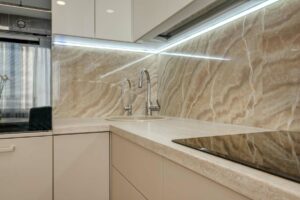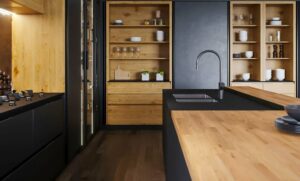The kitchen is often called the heart of the home, where family and friends gather to cook, eat, and spend quality time together. Having beautiful, durable and easy-to-maintain kitchen floors is crucial for both form and function.
When selecting new floors for your kitchen, there are several key factors to take into account based on your lifestyle, design aesthetic preferences, and budget. Carefully thinking through how you use your kitchen along with your goals for its style and longevity can help narrow down the myriad of flooring options into the best choice for your space.
This guide covers all the most popular kitchen flooring materials, including hardwood, tile, stone, vinyl, and even unique surfaces like concrete or cork. We’ll explore the pros and cons of each option along with costs, durability comparisons, and installation considerations. Whether seeking stylish kitchen flooring trends like mosaic tile, easy-to-clean kitchen floors like luxury vinyl plank, or classic finishes like oak hardwood, reading on will help you discover the perfect kitchen floors to elevate your home.
Hardwood Flooring

For many homeowners, wood floors represent the classic, elegant look that brings warmth and timeless beauty to a home. Given their natural appeal and value boost for resale, wood floors have remained popular over decades and make an excellent choice for kitchens designed in almost any style.
Wood Types of Flooring
There are a variety of wood species used for today’s hardwood flooring, each with their own distinct characteristics. Some top options include:
- Oak – A very popular choice known for its attractive grain patterns. Durable and resistant to everyday wear-and-tear.
- Maple – Primarily valued for its smooth, creamy appearance rather than bold grains. Resists warping.
- Hickory – Incredibly hard and dense wood that can withstand heavy impacts. Adds rustic flair.
- Ash – Nearly as durable as hickory but lighter in color. Offers visual interest with varied grain patterns.
- Others – More unique species like Brazilian cherry, bamboo, acacia, and pecan are also growing in popularity for home flooring.
Benefits of Wood Kitchen Floors
There are many advantages that make wood floors well-suited for kitchen installation:
- Aesthetics – Few materials can match the timeless beauty and sophistication of real wood floors, which elevate the design of any kitchen style from Farmhouse to Contemporary.
- Value – Wood floors can increase a home’s overall resale value significantly, making them a smart investment.
- Longevity – With proper care and maintenance, a quality hardwood floor can last 50 years or longer before needing replacement.
- Low Maintenance – When sealed correctly, wood flooring stands up well to daily activities and is easily cleaned using standard floor care products.
Drawbacks of Wood Kitchen Floors
Despite their desirability, there are a few potential downsides of using wood floors in kitchens:
- Durability Issues – Constant heavy foot traffic and moisture from spills can damage wood over time, especially softer species.
- High Upfront Cost – The total expense of quality wood flooring, professional installation, and finishing tends to be higher than alternative flooring options.
- Susceptible to Scratches – Being a natural product, even durable wood can get scratched, gouged from pet nails, or dented from heavy objects being dropped.
Cost of Wood Floors Installed
The total cost to install new hardwood floors in a kitchen can vary greatly depending on factors like:
- Type of wood species
- Floor grade (quality)
- Total square footage of flooring needed
- Any subfloor repair/replacement required
On average, most homeowners spend $3 to $15 per square foot installed for new wood flooring. Exotic and premium wood species tend to fall at the higher end of this spectrum, while domestic oak and pine floorboards tend to cost less overall.
It’s always smart to get multiple estimates from flooring contractors before finalizing your kitchen flooring budget.
Best Types of Wood for Kitchens by Feature
While almost any wood species can work well in kitchen spaces, some provide exceptional benefits that make them best suited for heavy-use kitchen environments:
- Durability – Hickory or maple floors stand up especially well to dropped pots/pans, pet nails, chair scratches and more thanks to their dense grain structure.
- Scratch Resistance – Materials like bamboo, pecan, and Brazilian cherry tend to better resist surface scratching from dragging furniture or utensils.
- Water Resistance – Teak’s natural oils help repel water, making it a great wood flooring choice surrounding sinks or dishwasher areas prone to spills.
Things to Keep in Mind About Wood Floors
Caring for real wood floors properly helps them last for decades rather than years. Here are some top maintenance tips for wood floor owners:
- Sweep/dust mop floors frequently and use approved hardwood floor cleaner for mopping (never wet mop).
- Periodically re-apply protective sealants or finishes according to manufacturer guidelines to repair scratches and shield from wear.
- Use area floor mats around sinks or workstations to reduce chances of water damage.
- Take care not to scratch floors with heels, furniture legs, or heavy appliances/equipment during kitchen use and cleaning.

Tile & Stone Flooring
Along with wood, tile remains one of the most popular kitchen flooring choices loved for its endless variety of colors, textures, shapes, and patterns. Stone surfaces like marble, granite, or slate also make stunning flooring options in Old World and Country kitchen designs.
Types of Tile/Stone for Kitchen Floors
There are numerous tile and natural stone materials suitable for kitchen installation, including:
- Ceramic – Classic and affordable tile option available in hundreds of styles.
- Porcelain – Similar to ceramic but denser and even more durable. Withstands moisture well.
- Natural Stone – Granite, marble, travertine and slate make beautiful, unique stone flooring if properly sealed.
- Mosaic – Small tile pieces arranged in decorative patterns for artistic flair.
- Quarry – Dense ceramic or porcelain tiles made for heavy foot traffic.
Benefits of Tile/Stone Kitchen Floors
Tile and stone floors provide several noticeable advantages for kitchen spaces:
- Durability – Ability to withstand dropped cookware, pet nails, stains and high moisture. Porcelain rated strongest.
- Easy to Clean – Non-porous tile and properly sealed stone resist spills, food stains, and dirt easily swept/mopped away.
- Trendy Styles – From bold patterns to realistic wood looks, the variety of new tile collections keeps this flooring option contemporary.
- Design Flexibility – Mix and match tile sizes, colors and materials for fully custom flooring.
Some drawbacks include potential for cracked tiles, hard surface fatigue, and the need to occasionally re-seal grout and stone. We’ll cover costs and maintenance tips next.
Cost of Tile/Stone Floors Installed
Like many home upgrades, kitchen tile or stone flooring costs largely depend on the materials used:
- Ceramic tile: $3 – $7 per square foot
- Porcelain tile: $7 – $15 per square foot
- Natural stone products: $15 – $30+ per square foot
Pro-tip: Order 10-15% extra flooring material beyond measurements to account for custom cuts and pattern matching.
Best Types of Tile/Stone by Feature
While porcelain, ceramic, and stone all enhance kitchen floors beautifully, some stand out when it comes to specific needs:
- Durability – Glazed porcelain provides incredible strength and stain resistance able to stand up to decades of heavy use.
- Low Maintenance – Standard ceramic requires very little upkeep beyond quick sweeping and damp mopping.
- Style – Natural stone like marble or mosaic tile creates high-end, artistic appeal unlike any other material.
Regardless of which tile or stone flooring you select, investing in professional installation and using high-quality grout and sealants drastically improves durability.
Things to Keep in Mind About Tile/Stone Floors
Caring for tile and stone floors properly ensures they stay looking like new for years instead of quickly appearing dingy or worn. Here are some top tips:
- Use cushioned mats in high traffic areas to prevent cracking tiles or stone.
- Re-apply sealants to grout lines and natural stone floors annually or bi-annually.
- Immediately address any cracked tiles, chipped stone, missing grout etc. to prevent further damage.
The next popular kitchen flooring category is resilient vinyl, which we’ll explore in the following section.
Vinyl Flooring

Known for its affordable pricing and great durability, vinyl has grown into one of the most popular kitchen flooring choices for busy families, rental properties, and contemporary design styles. Available in tile, sheet, and innovative plank formats, quality vinyl rivals the performance of materials costing two to three times as much.
Types of Vinyl Flooring for Kitchens
There are three main types of vinyl flooring suitable for kitchens:
- Luxury Vinyl Plank (LVP) – Floors that click together without glue for easy DIY installation. Made with a resilient core layered below vinyl veneers that resist moisture and scratching.
- Vinyl Tile – Traditional vinyl tiles measuring 12″ x 12″ across that glue directly to the subfloor. Grout between tile joints.
- Vinyl Sheet – Available on wide rolls for seamless installations or custom cuts. Often features printed color variations and textures.
Benefits of Vinyl Kitchen Floors
Vinyl has grown highly competitive with other flooring thanks to improvements in durability and visuals plus keeping costs comparatively low. Benefits include:
- Affordability – Materials, labor, and installation for vinyl is significantly less than most other flooring options.
- Durability – Modern vinyl outperforms past versions with denser cores and scratch-proof layers that shed dirt easily.
- Easy Maintenance – Requires no wax or sealants. Easy to routinely clean using vinyl-safe detergents and damp mopping.
- Realistic Looks – Many modern vinyl options mimic wood, tile, and stone with stunning realism.
Of course, there are a few potential disadvantages discussed next.
Drawbacks of Vinyl Kitchen Floors
While vinyl floor technology and durability improves all the time, there are still a few limitations to consider:
- Not Refinishable – Unlike wood floors that can be refinished, vinyl must be completely replaced if significantly damaged.
- Susceptible to Heat – Direct high heat exposure over time from appliances or hot pans can cause vinyl floors to bubble or discolor.
- Luxury Vinyl Scratches – Heavy furniture dragged across the surface can still scratch the top protective vinyl wear layer.
Now that we’ve covered the key pros and cons, let’s explore popular vinyl flooring costs.
Cost of Vinyl Floors Installed
One major advantage of vinyl flooring is its affordable price point compared to most other kitchen floor materials:
- Vinyl Sheet: Less than $2 per square foot installed
- Luxury Vinyl Plank: $2 – $6 per square foot installed
- Vinyl Tile: $1 – $4 per square foot installed
Bulk ordering vinyl flooring can also help lower costs, as extra materials often cannot be returned once ordered.
Best Vinyl Floor Types by Feature
The many vinyl flooring collections available mean there’s an ideal option for every kitchen’s needs:
- Realistic Looks – Luxury vinyl plank floors mimic wood and stone with stunning detail and texture. Brands like CoreLuxe feel indistinguishable from real hardwood when installed.
- Affordability – Basic vinyl sheet rolls offer homeowners the lowest cost installation covering large kitchens.
- Easy Install – Vinyl peel-and-stick tile goes down fast without glue or nails for convenient DIY projects.
Things to Keep in Mind About Vinyl Floors
A few simple care tips will keep vinyl floors looking like new for over a decade:
- Sweep and mop floors 1-2 times per week using vinyl floor cleaner.
- Move appliances/furniture carefully without dragging to prevent scratching.
- Be diligent about addressing scratches early – individual planks can be replaced if needed.
For exceptionally heavy use, choose commercial-grade vinyl wear layers for added protection.
Other Unique Kitchen Floor Options
If aiming for an especially modern or eco-friendly kitchen, consider these rare flooring ideas:
- Concrete Flooring – Poured concrete floors create an edgy, urban look. Stains and dyes can add color variation.
- Cork – Naturally water-resistant, anti-microbial, and comfortable underfoot. Made from renewable cork oak trees.
- Rubber – Extremely durable synthetic rubber able to withstand messy chef’s kitchens. Available in various colors.
While challenging to install, these floors make the ultimate non-traditional design statements for contemporary kitchens.






